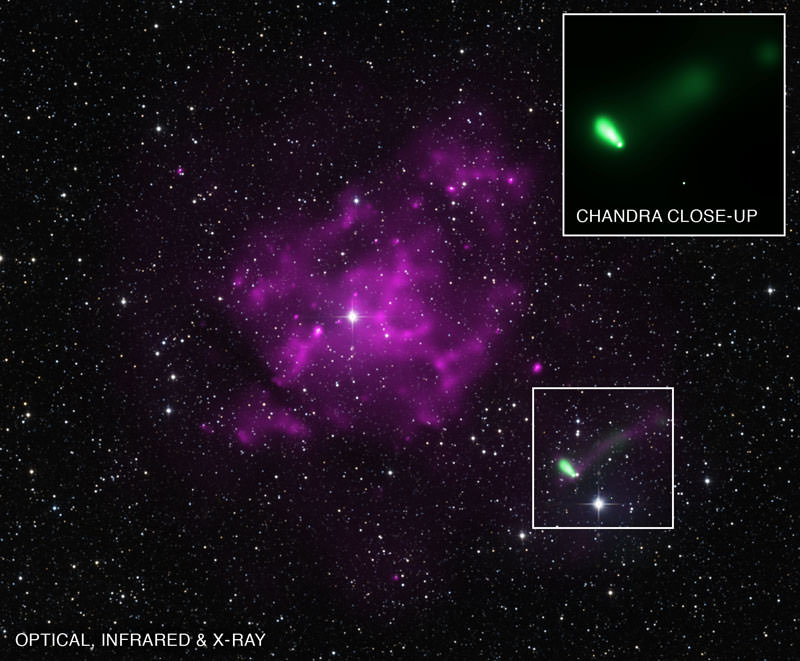A pulsar may have been spotted racing through space at over 6 million miles per hour (9.65 million km/h), setting a new speed record for these curious cosmic objects. If observations are what they appear to be, astronomers will have to recalculate the incredible forces created by supernova explosions.
Seen in observations made with 3 different telescopes — NASA’s Chandra X-ray Observatory, ESA’s XMM-Newton, and the Parkes radio telescope in Australia — the x-ray-emitting object IGR J11014-6103 appears to be racing away from the remnants of a supernova in the constellation Carina, 30,000 light-years from Earth.
The comet-shaped object is thought to be a pulsar, the rapidly-spinning, superdense remains of a star. The facts that it’s dim in optical and infrared wavelengths and hasn’t changed in x-ray brightness between XMM-Newton observations in 2003 and Chandra measurements in 2011 support the claim.
IGR J11014’s comet-like shape may be the result of its breakneck speed through space as its pulsar wind nebula gets blown back by the high-energy bow shock created at the forefront of its passage.
Pulsar wind nebulae are the results of charged particles streaming out from the pulsar itself. The particles, traveling at nearly light-speed, are rapidly decelerated by the interstellar medium and create a visible shock wave. In the case of IGR J11014, the pulsar wind is formed into a “tail” by its bow shock — effectively a sonic boom in front of it.
Further observations will be needed to confirm that IGR J11014 is indeed a pulsar, especially considering that actual pulsations have not yet been detected. If it is a pulsar, and is really traveling at the record-breaking speeds it appears to be — between 5.4 and 6.5 million miles per hour, more than 12 times faster than the Sun travels around the center of the galaxy — a new model of supernova explosions may be required.
Read more on the Chandra news release here.
Image: X-ray: NASA/CXC/UC Berkeley/J.Tomsick et al & ESA/XMM-Newton, Optical: DSS; IR: 2MASS/UMass/IPAC-Caltech/NASA/NSF. Video: NASA/CXC/A. Hobart.


Cool. Currently about 3 hours from listening to an entertaining talk by the discoverer of pulsars, Dame Jocelyn Bell Burnell. She is an invited speaker at the RASC General Assembly currently taking place in Edmonton, AB. I believe that the webcast will be aired live – 7:30 mountain time, 9:30 eastern, here http://edmontonrasc.com/2012ga/ga_webcast.html
Looks like a sub warp drive transporter to me, probably a future superhero
Around the time this story broke, a similar tale involving the discovery of a possible pulsar wind nebula(PWN) associated with the well-known Cygnus Loop SNR ( http://en.wikipedia.org/wiki/Cygnus_loop ) was announced.
Suzaku and XMM-Newton observations of the Cygnus Loop have revealed a diffuse x-ray nebula with an embedded point source located in the so-called southern blowout region of the SNR. As is the case with IGR J11014-6103, this candidate PWN has a (implied) high transverse velocity of ~1850 km/s. Also similar to the present case, actual pulsations from the source have not been detected, although optical and radio observations would seem to rule out a foreground star or background AGN as possibilities.
While the true nature of this source is unknown (a background galaxy cluster cannot be ruled out, for example) further observations may help determine if this object is the long-sought pulsar progenitor of the Cygnus Loop SNR.
Details of the study can be found here: http://arxiv.org/abs/1206.4367